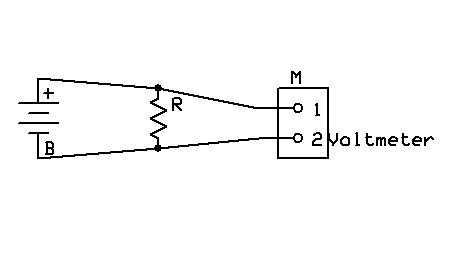In this blog post I will go over steps of testing a battery. This method is not just for golf cart batteries, it works with most batteries(although the resistance might be different) that give a good wattage without going over the wattage rating of the resistor. Another thing I should tell you is don’t forget to unhook the resistor when you are not using it. This is so that the battery does not get drained too much. You may be thinking don’t batteries voltage goes really low if the battery is bad. That is true, but there is a possible chance that the equivalent series resistance goes up and the voltage stays the same.
To figure out the maximum voltage for a a resistor use the following equation,where Vmax is the maximum voltage R is resistance and P is resistor power ratting
$$v_{max}=\sqrt{PR}$$
So for a 10 ohm 100W resistor,for the heating element tap into a section of the nichrome wire and measure it until you get a good small resistance for what is reasonable.
$$\sqrt{10*100}=\sqrt{1000}=31.623V$$
Since our battery is 24V it will work since it is less than 31V. But don’t stop there is 10 ohms small enough to give out a few amps without going over the amp-hour capacity. You can figure that out with ohms law equation. Where I is current, V is battery voltage and R is resistance:
$$I=\frac{V}{R}=\frac{24}{10}=2.4A$$
If we put two 10 ohm resistors in parallel you will get 4.8A and so on… Just don’t use too many where the current draws too much. I decided to get four of them. This gives a 2.5 ohm load which draws 9.6A, this is so that the current doesn’t overload the meter that I have. This will save you money(if you get a heating element. This is because the resistor has to be 100 watts and at all electronics it cost 5 dollars per resistor. Another option is to get a cheap heating element. The heating element is a better option because you can tap into the resistance needed and higher power. To get the correct resistance from a heater element divide the length of nichrome wire by the following equation:
$$L=\frac{v_{rated}}{v_{battery}}=\frac{240}{24}$$
Where Vrated is the original voltage rating(240v is typical dryer voltage) for the heater element,vbattery is the battery voltage and L is the length divider so with 24 volts you must not go below the original length divided by 10. So for element of 20 feet the minimum length is 2 feet,and so on…

Testing the battery
When I say measure I mean MEASURE it! Do not use what the specs say because your meter will probably be a little off. Do it for every time you hookup this circuit.
Step 1 Measure the resistor and do ohm’s law to figure out the maximum current it will draw. It must not go really over the amp hour rating of the battery
Step 2 Hook up the circuit to the battery and measure it voltage it should not drop below the 80% of the battery voltage for a maximum of 15 seconds.
Step 3. If it hardly dropped it’s good other wise it is bad, you can take your load test each battery one at a time

Originally rated voltage:V
Battery Voltage:V
Total length of nichrome wire:ft Use default for the one I used.
Lowest Length: ft
